If you're a student studying physics in CBSE Class 10 Science, you'll need to understand the concepts of light reflection and refraction. These notes provide a comprehensive overview of the topic, including definitions, formulas, and examples to help you prepare for exams and revise the material. You can download the pdf of these notes and take a printout of it.
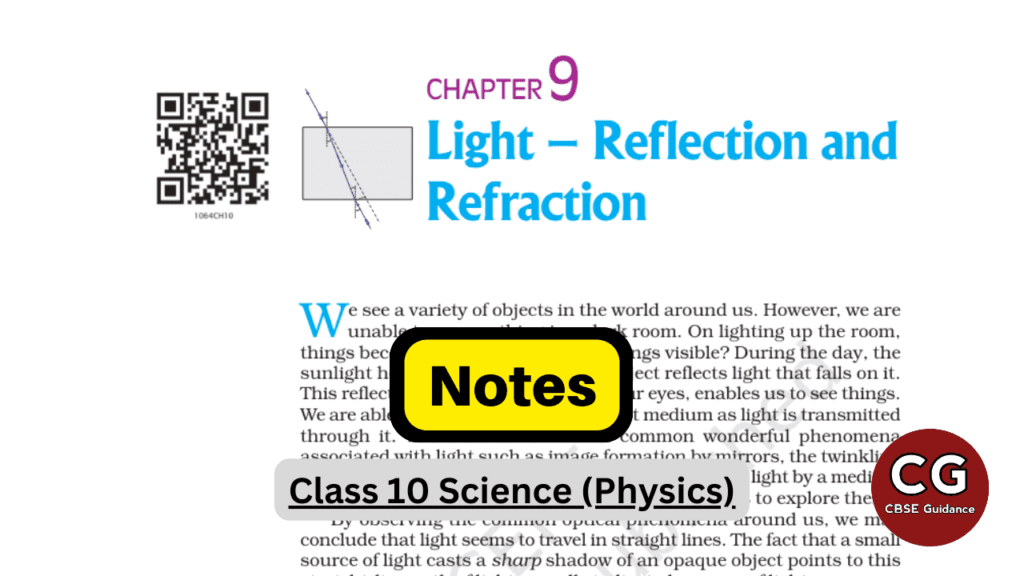
| Subject | Science (Physics) |
| Class | 10 |
| Board | CBSE |
| Chapter No. | 9 |
| Chapter Name | Light Reflection and Refraction |
| Type | Notes |
| Session | 2024-25 |
Many of life's failures are people who did not realize how close they were to success when they gave up.
- Thomas A. Edison
Light Reflection and Refraction Class 10 Notes
Table of Contents
Reflection of Light
The Laws of Reflection of Light
- The angle of incidence is equal to the angle of reflection,
- The incident ray, the normal to the mirror at the point of incidence, and the reflected ray, all lie in the same plane.
Formation of an image by a plane mirror:
- The image formed by a plane mirror is always virtual and erect.
- The size of the image is equal to that of the object.
Spherical Mirrors
- Such mirrors, whose reflecting surfaces are spherical, are called spherical mirrors.
- A spherical mirror, whose reflecting surface is curved inwards, that is, faces towards the center of the sphere, is called a concave mirror.
- A spherical mirror whose reflecting surface is curved outwards is called a convex mirror.
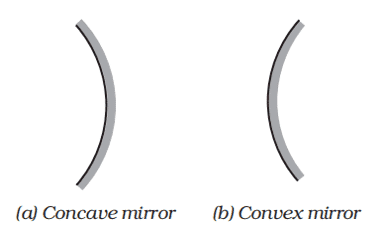
Some Important Terms:
- Pole (P)
- Center of Curvature (C)
- Radius of Curvature (R)
- Principal Axis
Principal focus of the concave mirror (F): When a number of rays parallel to the principal axis is falling on a concave mirror. The reflected rays all meet/intersect at a point on the principal axis of the mirror. This point is called the principal focus of the concave mirror
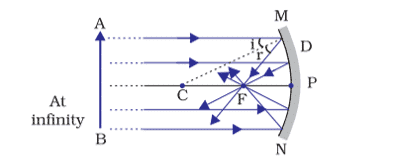
Principal focus of the convex mirror (F): When a number of rays parallel to the principal axis is falling on a convex mirror. The reflected rays appear to come from a point on the principal axis of the mirror. This point is called the principal focus of the convex mirror.
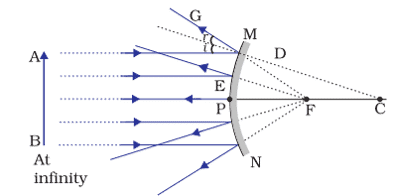
Focal length (f): The distance between the pole and the principal focus of a spherical mirror is called the focal length. It is represented by the letter f.
Aperture: The diameter of the reflecting surface of a spherical mirror is called its aperture. [the distance MN in the above figures]
Relationship between R (radius of curvature) and f (focal length):
R = 2f
Image Formation by Concave Mirror
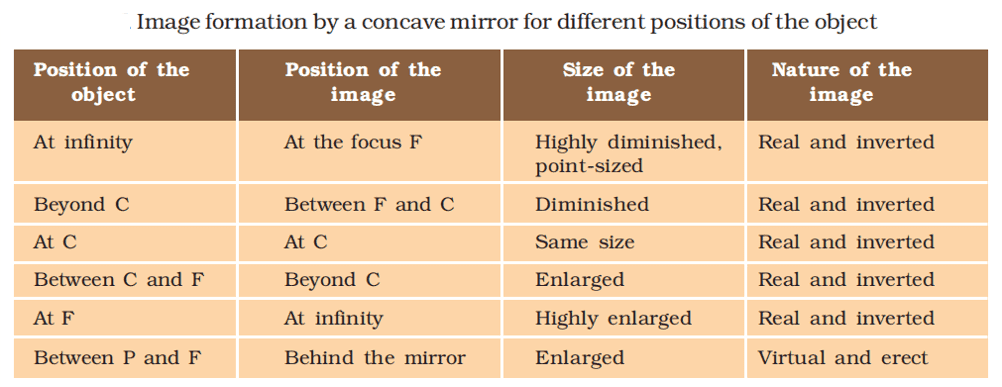
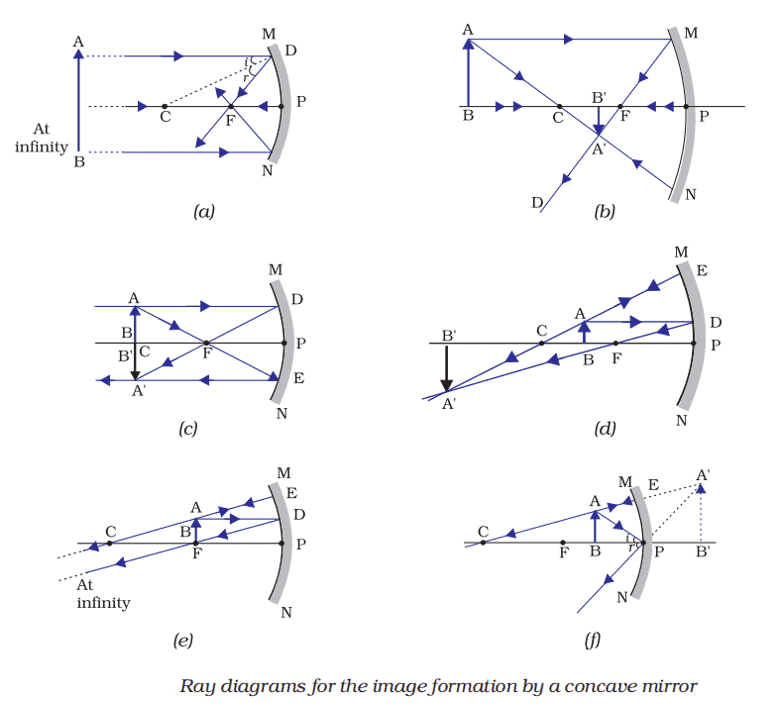
Uses of Concave Mirrors:
- Concave mirrors are commonly used in torches, searchlights, and vehicle headlights to get powerful parallel beams of light.
- They are used as shaving mirrors to see a larger image of the face.
- Dentists use concave mirrors to see large images of the teeth of patients.
- Large concave mirrors are used to concentrate sunlight to produce heat in solar furnaces.
Image Formation by Convex Mirror


Note: You can see a full-length image of a tall building/tree in a small convex mirror.
Uses of Convex Mirrors
- Convex mirrors are commonly used as rear-view (wing) mirrors in vehicles.
- Because:
- They always give an erect, though diminished, image.
- Also, they have a wider field of view as they are curved outwards
Sign Convention for Reflection by Spherical Mirrors
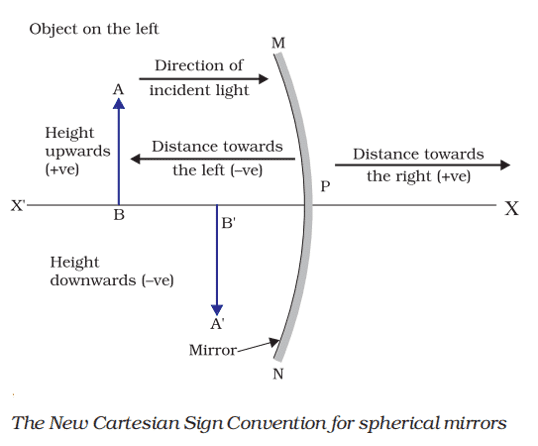
- The object is always placed to the left of the mirror. [i.e., object distance (u) is always taken as negative (-)].
- All distances parallel to the principal axis are measured from the pole of the mirror.
- The focal length of a convex mirror is positive and that of a concave mirror is negative.
Mirror Formula and Magnification
| Mirror Formula |  |
| Magnification |
- The height of the image should be taken as positive for virtual images and negative for real images.
- A negative sign in the value of the magnification indicates that the image is real.
- A positive sign in the value of the magnification indicates that the image is virtual.
Refraction of Light
Definition: Light does not travel in the same direction in all media. It appears that when traveling obliquely from one medium to another, the direction of propagation of light in the second medium changes. This phenomenon is known as the refraction of light.
Refraction through a Rectangular Glass Slab
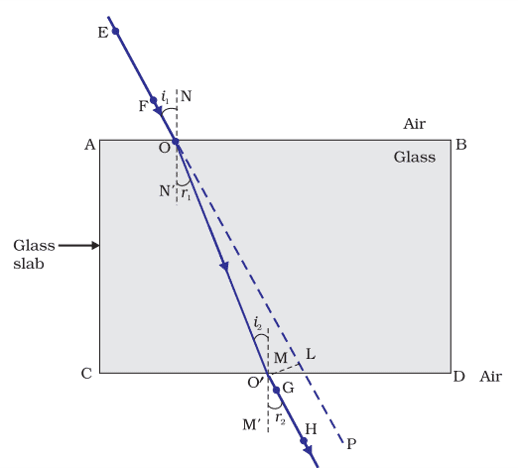
| EO | Incident ray |
| OO' | Refracted ray |
| O'H | Emergent ray |
| ∠EON | Angle of incidence |
| ∠N'OM | Angle of Refraction |
- The light ray at point O has entered from a rarer medium (air) to a denser medium (glass). Note that the light ray has bent towards the normal.
- At O′, the light ray has entered from glass to air, that is, from a denser medium to a rarer medium. The light here has bent away from the normal.
- The emergent ray is parallel to the direction of the incident ray because:
- The extent of bending of the ray of light at the opposite parallel faces AB (air-glass interface) and CD (glass-air interface) of the rectangular glass slab is equal and opposite. This is why the ray emerges parallel to the incident ray.
The laws of refraction of light
- The incident ray, the refracted ray, and the normal to the interface of two transparent media at the point of incidence, all lie in the same plane.
- The ratio of the sine of the angle of incidence to the sine of the angle of refraction is a constant, for the light of a given color and for the given pair of media. This law is also known as Snell’s law of refraction. (This is true for angle 0° < i < 90°)
If i is the angle of incidence and r is the angle of refraction, then,

The Refractive Index
Let v1 be the speed of light in medium 1 and v2 be the speed of light in medium 2. The refractive index of medium 2 with respect to medium 1 is given by the ratio of the speed of light in medium 1 and the speed of light in medium 2. This is usually represented by the symbol n21.

Similarly, the refractive index of medium 1 w.r.t. medium 2 is

If medium 1 is vacuum or air, then the refractive index of medium 2 is considered with respect to vacuum. This is called the absolute refractive index or simply the refractive index of the medium. It is simply represented as n2.

Meaning of the statement "The refractive index of water, nw = 1.33"
This means that the ratio of the speed of light in air and the speed of light in water is equal to 1.33.
Note: If the refractive index of medium x is nx and that of medium y is ny, then the refractive index of medium x w.r.t medium y is nxy = nx/ny.
Refraction by Spherical Lenses
Lens: A transparent material bound by two surfaces, of which one or both surfaces are spherical, forms a lens. This means that a lens is bound by at least one spherical surface. In such lenses, the other surface would be plane.
Convex Lens
- A lens may have two spherical surfaces, bulging outwards. Such a lens is called a double convex lens. It is simply called a convex lens.
- It is thicker in the middle as compared to the edges.
- Convex lens converges light rays as shown in the figure below. Hence convex lenses are also called converging lenses.
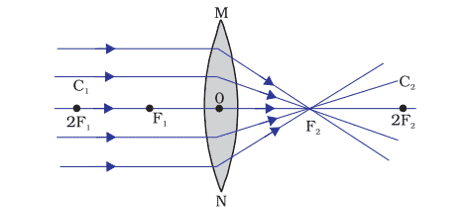
Concave Lens
- A double concave lens is bounded by two spherical surfaces, curved inwards. A double concave lens is simply called a concave lens.
- It is thicker at the edges than at the middle.
- Such lenses diverge light rays as shown in the figure below. Such lenses are also called diverging lenses.
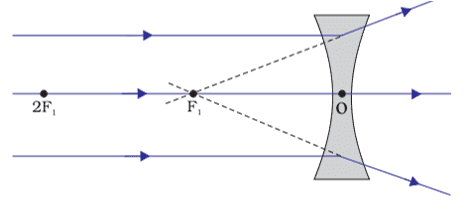
Some Important terms
- Center of Curvatures (C1 and C2)
- Principal axis
- Optical center (O)
- Principal focus of convex lens (F): When several rays of light parallel to the principal axis fall on a convex lens, these rays, after refraction from the lens, converge to a point on the principal axis. This point on the principal axis is called the principal focus of the convex lens.
- Principal focus of concave lens (F): When several rays of light parallel to the principal axis fall on a concave lens, these rays, after refraction from the lens, appear to diverge from a point on the principal axis. This point on the principal axis is called the principal focus of the concave lens.
- Focal length (f): The distance of the principal focus from the optical center of a lens is called its focal length.
Image Formation by Convex Lens
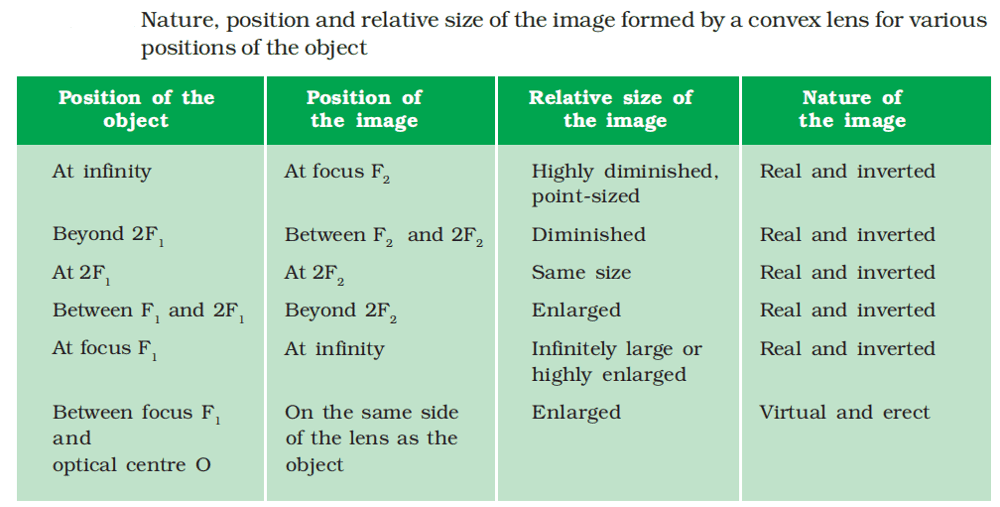
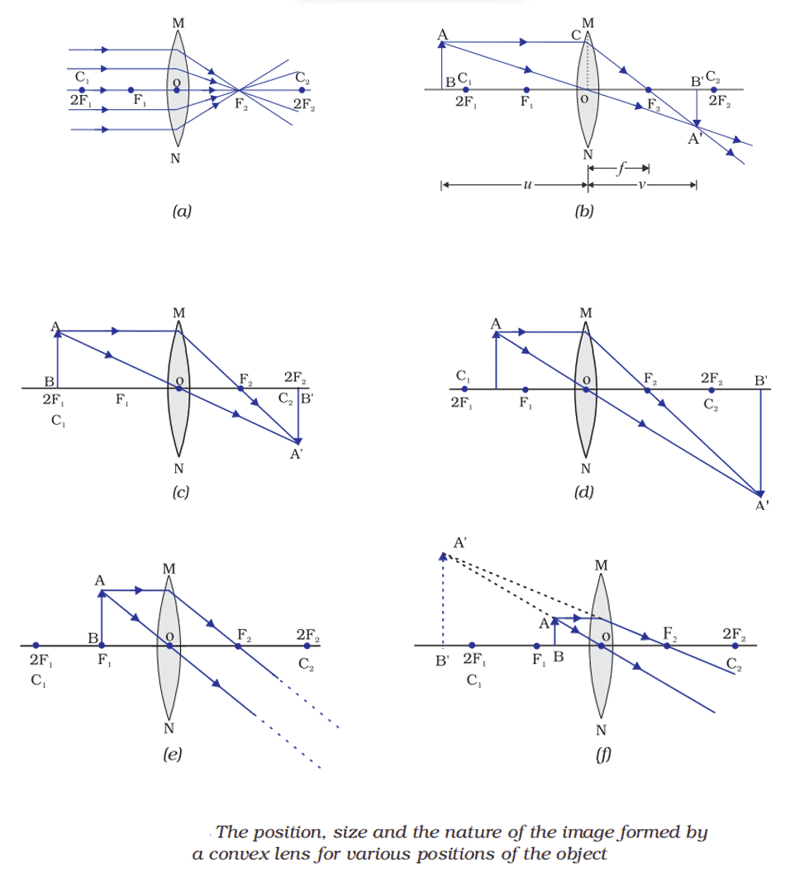
Image Formation by Concave Lens

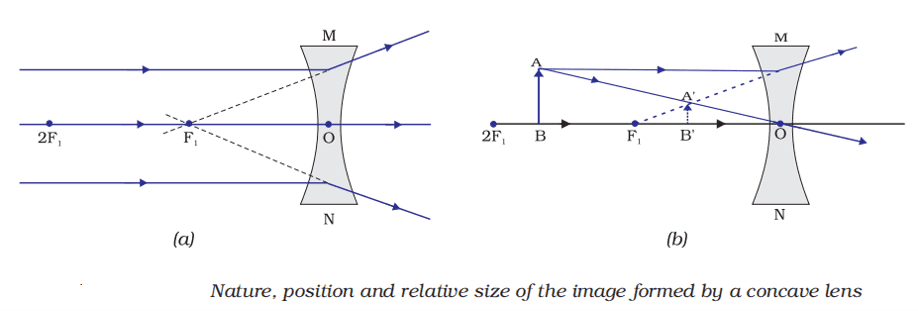
Sign Convention for Spherical Lenses
- The focal length of a convex lens is positive and that of a concave lens is negative.
- The object is always placed to the left of the lens. [i.e., object distance (u) is always taken as negative (-)].
- All distances parallel to the principal axis are measured from the optical center.
Lens Formula and Magnification
| Lens Formula |  |
| Magnification |
Power of a Lens
- The power of a lens is defined as the reciprocal of its focal length. It is represented by the letter P. The power P of a lens of focal length f is given by P = 1/f
- The SI unit of power of a lens is ‘dioptre’ (D)
- If f is expressed in meters, then, power is expressed in dioptres.
- 1 dioptre: 1 dioptre is the power of a lens whose focal length is 1 meter. 1D = 1m–1
- The power of a convex lens is positive and that of a concave lens is negative.
- Meaning of "The power of a lens is +2.0 D"
- The lens is convex.
- The focal length of the lens is + 0.50 m.
- Meaning of "The power of a lens is -2.5 D"
- The lens is concave.
- The focal length of the lens is -0.40 m.
Hope you liked these notes. Please share this with your friends and do comment if you have any doubts/suggestions to share.
Sooooooooooooooooooooooooooooooooooooooooooooooooooooooooooooo nice bestttttttttttttttttttttttttttttttttt for studentsssssssssssssssssssssssss
Thank you very much ♥️♥️♥️♥️♥️♥️♥️♥️♥️♥️♥️♥️♥️♥️♥️♥️♥️♥️♥️♥️♥️♥️♥️♥️♥️♥️♥️♥️♥️♥️♥️♥️♥️♥️♥️♥️♥️♥️♥️♥️♥️♥️♥️♥️♥️♥️♥️♥️♥️♥️♥️♥️♥️♥️♥️♥️
poda
Fast of all , i want to says you helped me lot by providing important questions and answers. So , THANK YOU SO MUCH SIR 🙏🙏🙏🙏. Sir i wants important questions and answers of maths .
———‘ROHAN KUMAR’—————-
It’s already uploaded
It’s an wonderful notes to crack cbse board exam 2024. Thank you for your precious notes